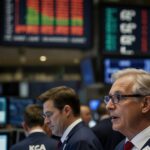The United States stock market suffered a huge decline on Tuesday due to the Dow Jones Industrial Average dropping for the second day in a row, thus losing more than 1,300 points in a mere two days. This rapid decrease was caused by President Donald Trump’s newly imposed tariffs on Canada, Mexico, and China which took effect, creating fears of an escalating trade war.
By midday Eastern time (ET), all 11 sectors of the S&P 500 were down, with almost 80% of the index’s stocks showing lower performance. The broad-based sell-off has completely eliminated all the market’s gains for the year, thus making the S&P 500’s year-to-date performance negative by almost 2%.
Best Buy was the worst performer among the 500 companies that made up the S&P 500, falling more than 15% after CEO Corie Barry mentioned that price hikes were “very possible” as a result of the newly imposed tariffs. Royal Caribbean and KKR were among other prominent losers, with their shares dipping by more than 7% each.
One particular area in the financial sector suffered greatly, seeing its greatest single-day decrease since the Banking Crisis of 2023. The sector went down by 3.8% in late morning trading, making it the weakest sector out of the eleven. If this tendency remains until the market closes, that will be its most pronounced decline since March 9, 2023.
By the way, big US banks faced adverse news as well during the market downturn. Citigroup went down the most with 8%, while Wells Fargo lost 6.8%, Bank of America 6.5%, and JPMorgan 5.2%. All four are now below their high points of the year by more than 10%, and so they are in a correction phase.
The social media platform Truth Social was President Trump’s witness this time. Trump had government support behind him claiming that US banks were not allowed to do business in Canada after Canada placed a 25% tariff on their imports. But, although Canada’s banking industry is quite regulated, US banks are, as a matter of fact, allowed to operate in Canada.
Along of the automotive industry, it became also a subject of the trade war. A statement from the American Automotive Policy Council was the reason for the Stock prices of the major car producers like Stellantis, Ford Motor, and General Motors to go down. The statement was advocating for the application of a tariff increase to only those who commit with USMCA.
There was also a drop in tech shares. On Monday, Nvidia’s stock price did not stop its 3% decrease, which brings it near a 9% loss due to concerns about the impact of tariffs on its Chinese business. Trading in the premarket for Tesla was also down 3%, given detracting news according to which it is the China factory that caused the sales to plummet by almost 50% on a year-over-year basis in February.
The market’s immediate reaction is an illusion of growing clamor on the potential economic impact of such trade friction. Accumulated prices may be a result of companies and people who have no other choice but to pay more for products, which in turn, will contract the economy and reduce business income.
Despite negative dynamics of the stock market, the rare sector that showed an almost unchanged situation turned out to be the S&P 500 Consumer Staples. Walgreens soared 6.3% after upbeat reports of the Samore deal in Q3 with no concrete details coming out, implying a potential $10 billion private buyout.
As the trade war progresses, stakeholders are very interested in any whisper of possible settlement or an intensification of the conflict. Lutnick mentioned that the negotiations might include a certain drop in the new tariffs. However, the US Secretary of Commerce, regarding particularly Canada and Mexico, Howard Lutnick, has dangled a carrot in the form of tariff discussions where the trade partners could agree to a certain scale back of new tariffs.
Today the global importance of these trade war tensions becomes more apparent than it was last year. China through a statement by its officials said that as an initial measure it intends to slap its own taxes on US products, and it said further to engage in a “kill-or-be-killed” situation.
This, in turn, has eaten into positive sentiment and future prospects of a record worldwide expansion with both countries involved in the dispute. Therefore, Kirimi, the analyst, says it has plunged the rest of the world
In harmony with that, the markets are the first line that responds all these news there is. In these days, the strength and volume of the world’s interconnection of markets and the great impact of the world’s trade policies have been clearly demonstrated. Therefore, volatility of the global markets is a clear reminder of the interconnectedness of global markets and the far-reaching impacts of trade policies.
Going forward the traders, of course, will be following closely the economic data, the corporate earnings reports and any further developments concerning trade negotiations. The adaptability of the companies to overcome these difficulties and cope with the trade tides of change will, without a doubt, most probably be a driving factor in determining the market performance in the months to come.





